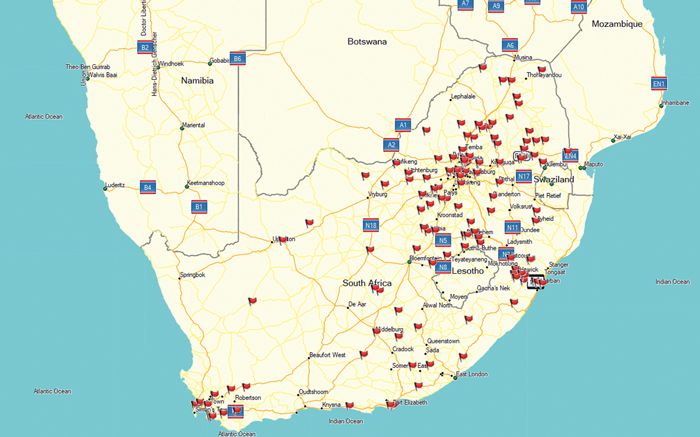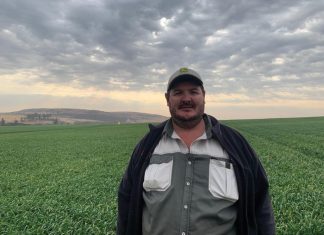
curator: NFC, ARC-PPRI
 Piet van Niekerk,
Piet van Niekerk,technician: Pesticide Unit, ARC-Plant Health and Protection
Fungi are an extremely diverse and abundant group of microbes. They are eukaryotic and don’t possess chlorophyll like plants. They get their food by decomposing matter or consuming off their hosts as parasites.
Reproduction happens through numerous spores rather than pollen, fruit or seeds and they are non-motile. Fungi are particularly important – having an impact on human, plant and animal health as well as the functioning of natural ecosystems. They provide various ecosystem services, such as decomposition, that is necessary for many of the cycles of life, including the carbon, nitrogen and oxygen cycles. By breaking down organic matter, fungi release these gases into the soil and the atmosphere.
However, more than 90% of the estimated 3,8 million fungi in the world are currently unknown to science. They are some of the most overlooked organisms, despite making up 25% of the world’s biomass. Scientists divided fungi into four groups: Zygomycota, Ascomycota (sac fungi), Basidiomycota (club fungi) and Deuteromycota (imperfect fungi). The Basidiomycota include the mushrooms and bracket fungi, while the Ascomycota include those fungi that produce small fruiting structures that are still visible without the aid of a microscope. The Zygomycota are the common bread moulds – most of these live on decaying plant and animal matter. Fungi in the Deuteromycota have no known sexual stage and most live on land, with a few aquatic exceptions. They have a great number of human uses – most significant being the production of antibiotics for medicinal use. These substances are produced by the fungus to inhibit the growth of other living organisms around them and are extracted from the fungus and used to kill bacteria in the human body.
The NCF and agriculture
The National Collection of Fungi (NCF) has for the past 115 years documented the fungal diversity associated with agricultural crops in South Africa. The first accounts on the fungal diversity of the country are from European botanical explorers who collected Southern African fungi for scientific study, venturing to the subcontinent in the late 1700s. Carl Peter Thunberg, a Swedish naturalist and student of Carl Linnaeus, gathered the first record of a plant pathogen on an indigenous host in South Africa – the noticeable ascomycete Corynelia uberata on a yellow-wood tree, a species of Podocarpus (Knox-Davies, 1977).
This was followed by sporadic reports until I.B. Pole-Evans was officially appointed as the first mycologist by the British government. His appointment served as the first official recognition of mycology as a distinct branch of research in the country (Bottomley, 1929). In 1905, he became the head of mycology and plant pathology in the newly established Transvaal Department of Agriculture, and chief of the division of botany for the whole of South Africa (Pole-Evans, 1916).
In the same year he established a plant-pathological reference collection, the forerunner of the current NCF (Doidge, 1950).
Since then the NCF’s role in the South African landscape has been influenced by numerous socio-economic and political events, including two world wars. Most recently, global focus on the conservation of biodiversity has had a major impact on the role the collection plays in informing policy documents such as the National Biodiversity Assessment (NBA). The assessment serves as a primary tool for monitoring and reporting on the state of biodiversity in South Africa. It is used to inform policies, strategies and actions in a range of sectors in order to manage and conserve biodiversity more effectively.
The basic goals of the NCF remained integral throughout, although various phases in terms of research focus are recognised over the past 115 years. These include an emphasis on the collection and the recording of fungal pathogens, followed by a focus on mycotoxins and recently the documentation of biodiversity. There is also an increasing demand for information and diagnostics surrounding plant pathogens. Currently, research at the NCF focusses on the surveys of native and agricultural ecosystems, molecular phylogenetics and species identification.
Documenting DNA
DNA barcoding is a routine tool used for quick and reliable identification of fungal species, but the results are only as reliable as the robustness of the reference dataset. Towards this goal, the NCF has started a project to generate DNA barcodes for all isolates housed in the Plant Protection Research Institute (PPRI) living fungal collection of the NCF, as well as documenting all DNA sequence data generated for material housed in the PREM fungorium. Not only do these DNA Sanger sequences serve as verification for the morphological identification, it may indicate species where further taxonomic work is required to resolve species boundaries. As these are all made available via international databases (NCBI GenBank and BOLD) it contributes to the international and local efforts to improve the diagnoses of fungal plant pathogens.
Data generation, including DNA barcodes, contributes towards supporting agriculture as a major role-player in the South African economy. It informs efforts towards agricultural resilience, biodiversity monitoring, bioregional planning, understanding the impacts of global change on biodiversity and the control of disease vectors. Towards the mobilisation of the NCF’s data, a number of crops were identified as priority and the known sampling sites for these were mapped as part of a knowledge gap analysis. One such crop is maize (Zea mays L.), produced throughout South Africa under diverse environments. The NCF has 522 specimens/entities from this crop, documented from 140 localities, including the 11th sample accessioned into the collection (Figure 1).

Another example of NCF specimens supporting agricultural research, is the studies on wheat stem rust. Rust fungi are obligate parasites and require living host tissue for growth and reproduction. In the absence of living host tissue, they survive as spores. In the case of the genus Puccinia it requires two unrelated host plants, such as wheat and barberry, to complete their life cycle. According to historical records the first documented epidemic of wheat stem rust occurred in the south-western parts of the current Western Cape in 1726. Although stem rust is caused by a single species of fungus, Puccinia graminis, there is considerable genetic variation within the species. Using specimens from Southern Africa (housed in the PREM fungorium), the genetic diversity across Africa could be studied. Some of the specimens used were more than 100 years old. In order to ensure that the NCF can fulfil its mandate to support the agricultural sector for the next 115 years, expansion and safekeeping are vital.
References
- Bottomley, AM. 1929. The development of South African mycology and of the mycological herbarium at Pretoria. South African Journal of Science, 26, 326 – 331.
- Doidge, EM. 1950. The South African fungi and lichens to the end of 1945. Bothalia, 5, 1 – 1094.
- Knox-Davies, PS. 1977. The science of plant pathology is 100 years old. SA Plant Pathologist, 7, 12 (Newsletter: Southern African Society for Plant Pathology).
- Pole-Evans, IB. 1916. A sketch of the rise, growth and development of mycology in South Africa. South African Journal of Science, 13, 97 – 116.


















